- ubuntu12.04环境下使用kvm ioctl接口实现最简单的虚拟机
- Ubuntu 通过无线网络安装Ubuntu Server启动系统后连接无线网络的方法
- 在Ubuntu上搭建网桥的方法
- ubuntu 虚拟机上网方式及相关配置详解
CFSDN坚持开源创造价值,我们致力于搭建一个资源共享平台,让每一个IT人在这里找到属于你的精彩世界.
这篇CFSDN的博客文章详解Java豆瓣电影爬虫——小爬虫成长记(附源码)由作者收集整理,如果你对这篇文章有兴趣,记得点赞哟.
以前也用过爬虫,比如使用nutch爬取指定种子,基于爬到的数据做搜索,还大致看过一些源码。当然,nutch对于爬虫考虑的是十分全面和细致的。每当看到屏幕上唰唰过去的爬取到的网页信息以及处理信息的时候,总感觉这很黑科技。正好这次借助梳理Spring MVC的机会,想自己弄个小爬虫,简单没关系,有些小bug也无所谓,我需要的只是一个能针对某个种子网站能爬取我想要的信息就可以了。有Exception就去解决,可能是一些API使用不当,也可能是遇到了http请求状态异常,又或是数据库读写有问题,就是在这个报exception和解决exception的过程中,JewelCrawler(儿子的小名)已经可以能够独立的爬取数据,并且还有一项基于Word2Vec算法做个情感分析的小技能.
后面可能还会有未知的Exception等着解决,也有一些性能需要优化,比如和数据库的交互,数据的读写等等。但是目测年内没有太多精力放这上面了,所以今天做一个简单的总结,而且前两篇主要侧重的是功能和结果,这篇来说说JewelCrawler是如何诞生的,并将代码放到Github上(源码地址在文章最后),有兴趣的可以关注下(仅供交流学习,请勿他用,考虑下douban君。多一点真诚,少一点伤害) 。
环境介绍 。
开发工具:Intellij idea 14 。
数据库: Mysql 5.5 + 数据库管理工具Navicat(可用来连接查询数据库) 。
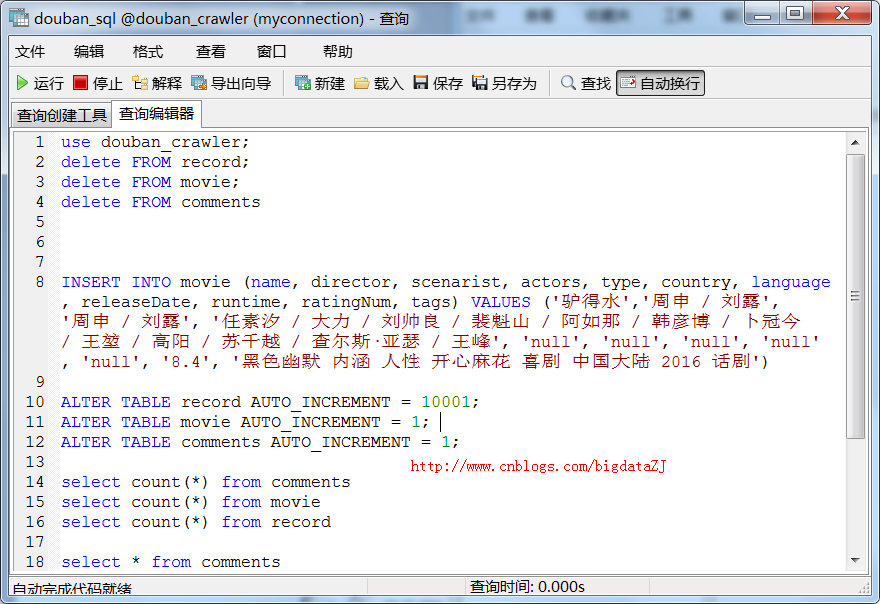
语言:Java 。
Jar包管理:Maven 。
版本管理:Git 。
目录结构 。
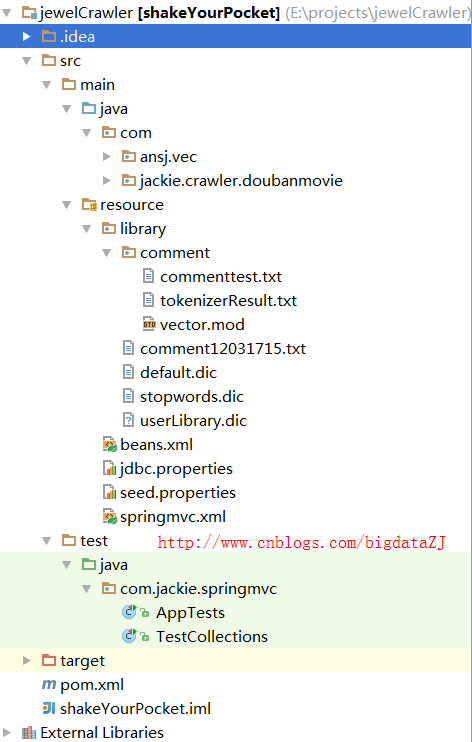
其中 。
com.ansj.vec是Word2Vec算法的Java版本实现 。
com.jackie.crawler.doubanmovie是爬虫实现模块,其中又包括 。
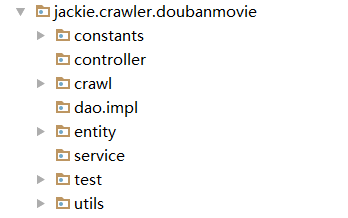
有些包是空的,因为这些模块还没有用上,其中 。
constants包是存放常量类 。
crawl包存放爬虫入口程序 。
entity包映射数据库表的实体类 。
test包存放测试类 。
utils包存放工具类 。
resource模块存放的是配置文件和资源文件,比如 。
beans.xml:Spring上下文的配置文件 。
seed.properties:种子文件 。
stopwords.dic:停用词库 。
comment12031715.txt:爬取的短评数据 。
tokenizerResult.txt:使用IKAnalyzer分词后的结果文件 。
vector.mod:基于Word2Vec算法训练的模型数据 。
test模块是测试模块,用于编写UT. 。
数据库配置 。
1. 添加依赖的包 。
JewelCrawler使用的maven管理,所以只需要在pom.xml中添加相应的依赖就可以了 。
|
1
2
3
4
5
6
7
8
9
10
11
12
13
14
15
16
17
18
19
20
21
22
23
24
25
26
27
28
29
30
31
32
33
34
35
36
37
38
39
40
41
42
43
44
45
46
47
48
49
|
<
dependency
>
<
groupId
>org.springframework</
groupId
>
<
artifactId
>spring-jdbc</
artifactId
>
<
version
>4.1.1.RELEASE</
version
>
</
dependency
>
<
dependency
>
<
groupId
>commons-pool</
groupId
>
<
artifactId
>commons-pool</
artifactId
>
<
version
>1.6</
version
>
</
dependency
>
<
dependency
>
<
groupId
>commons-dbcp</
groupId
>
<
artifactId
>commons-dbcp</
artifactId
>
<
version
>1.4</
version
>
</
dependency
>
<
dependency
>
<
groupId
>mysql</
groupId
>
<
artifactId
>mysql-connector-java</
artifactId
>
<
version
>5.1.38</
version
>
</
dependency
>
<
dependency
>
<
groupId
>mysql</
groupId
>
<
artifactId
>mysql-connector-java</
artifactId
>
<
version
>5.1.38</
version
>
</
dependency
>
|
2. 声明数据源bean 。
我们需要在beans.xml中声明数据源的bean 。
|
1
2
3
4
5
6
7
8
9
10
11
12
13
|
<
context:property-placeholder
location
=
"classpath*:*.properties"
/>
<
bean
id
=
"dataSource"
class
=
"org.apache.commons.dbcp.BasicDataSource"
destroy-method
=
"close"
>
<
property
name
=
"driverClassName"
value
=
"${jdbc.driver}"
/>
<
property
name
=
"url"
value
=
"${jdbc.url}"
/>
<
property
name
=
"username"
value
=
"${jdbc.username}"
/>
<
property
name
=
"password"
value
=
"${jdbc.password}"
/>
</
bean
>
|
注意: 这里是绑定了外部配置文件jdbc.properties,具体数据源的参数从该文件读取.
如果遇到问题“SQL [insert into user(id) values(?)]; Field 'name' doesn't have a default value;”解决方法是设置表的相应字段为自增长字段.
解析页面遇到的问题 。
对于爬到的网页数据需要解析dom结构,拿到自己想要的数据,期间遇到如下错误 。
org.htmlparser.Node不识别 。
解决方法:添加jar包依赖 。
|
1
2
3
4
5
6
7
8
9
|
<
dependency
>
<
groupId
>org.htmlparser</
groupId
>
<
artifactId
>htmlparser</
artifactId
>
<
version
>1.6</
version
>
</
dependency
>
|
org.apache.http.HttpEntity不识别 。
解决方法:添加jar包依赖 。
|
1
2
3
4
5
6
7
8
9
|
<
dependency
>
<
groupId
>org.apache.httpcomponents</
groupId
>
<
artifactId
>httpclient</
artifactId
>
<
version
>4.5.2</
version
>
</
dependency
>
|
当然这是期间遇到的问题,最后用的是Jsoup做的页面解析.
maven仓库下载速度慢 。
之前使用的是默认的maven中央仓库,下载jar包的速度很慢,不知道是我的网络问题还是其他原因,后来在网上找到了阿里云的maven仓库,更新后,相比之前简直是秒下,吐血推荐.
|
1
2
3
4
5
6
7
8
9
10
11
12
13
14
15
|
<
mirrors
>
<
mirror
>
<
id
>alimaven</
id
>
<
name
>aliyun maven</
name
>
<
url
>http://maven.aliyun.com/nexus/content/groups/public/</
url
>
<
mirrorOf
>central</
mirrorOf
>
</
mirror
>
</
mirrors
>
|
找到maven的settings.xml文件,添加这个镜像即可.
读取resource模块下文件的一种方法 。
比如读取seed.properties文件 。
|
1
2
3
4
5
6
7
8
9
|
@Test
public
void
testFile(){
File seedFile =
new
File(
this
.getClass().getResource(
"/seed.properties"
).getPath());
System.out.print(
"==========="
+ seedFile.length() +
"==========="
);
}
|
有关正则表达式 。
使用regrex正则表达式的时候,如果匹配上了定义的Pattern,则需要先调用matcher的find方法然后才能使用group方法找到子串。直接调用group方法是没有办法找到你想要的结果的.
我看了下上面Matcher类的源码 。
|
1
2
3
4
5
6
7
8
9
10
11
12
13
14
15
16
17
18
19
20
21
22
23
24
25
26
27
28
29
30
31
32
33
34
35
36
37
38
39
40
41
42
43
44
45
46
47
48
49
50
51
52
53
54
55
56
57
58
59
60
61
62
63
64
65
66
67
68
69
70
71
72
73
74
75
76
77
78
79
80
81
82
83
84
85
86
87
88
89
90
91
92
93
94
95
96
97
98
99
100
101
102
103
104
105
106
107
108
109
110
111
112
113
114
115
116
117
118
119
120
121
122
123
124
125
126
127
128
129
130
131
132
133
134
135
136
137
138
139
140
141
142
143
144
145
146
147
148
149
150
151
152
153
154
155
156
157
158
159
160
161
162
163
164
165
166
167
168
169
170
171
172
173
174
175
176
177
178
179
180
181
182
183
184
185
186
187
188
189
190
191
192
193
194
195
196
197
198
199
200
201
202
203
204
205
206
207
208
209
210
211
212
213
214
215
216
217
218
219
220
221
222
223
224
225
226
227
228
229
230
231
232
233
234
235
236
237
238
239
240
241
242
243
244
245
246
247
248
249
250
251
252
253
254
255
256
257
258
259
260
261
262
263
264
265
266
267
268
269
270
271
272
273
274
275
276
277
278
279
280
281
282
283
284
285
286
287
288
289
290
291
292
293
294
295
296
297
298
299
300
301
302
303
304
305
306
307
308
309
310
311
312
313
314
315
316
317
318
319
320
321
322
323
324
325
326
327
328
329
330
331
332
333
334
335
336
337
338
339
340
341
342
343
344
345
346
347
348
349
350
351
352
353
354
355
356
357
358
359
360
361
362
363
364
365
366
367
368
369
370
371
372
373
374
375
376
377
378
379
380
381
382
383
384
385
386
387
388
389
390
391
392
393
394
395
396
397
398
399
400
401
402
403
404
405
406
407
408
409
410
411
412
413
414
415
416
417
418
419
420
421
422
423
424
425
426
427
428
429
430
431
432
433
434
435
436
437
438
439
440
441
442
443
444
445
446
447
448
449
450
451
452
453
454
455
456
457
458
459
460
461
462
463
464
465
466
467
468
469
470
471
472
473
474
475
476
477
478
479
480
481
482
483
484
485
486
487
488
489
490
491
492
493
494
495
496
497
498
499
500
501
502
503
504
505
506
507
508
509
510
511
512
513
|
package
java.util.regex;
import
java.util.Objects;
public
final
class
Matcher
implements
MatchResult {
/**
* The Pattern object that created this Matcher.
*/
Pattern parentPattern;
/**
* The storage used by groups. They may contain invalid values if
* a group was skipped during the matching.
*/
int
[] groups;
/**
* The range within the sequence that is to be matched. Anchors
* will match at these "hard" boundaries. Changing the region
* changes these values.
*/
int
from, to;
/**
* Lookbehind uses this value to ensure that the subexpression
* match ends at the point where the lookbehind was encountered.
*/
int
lookbehindTo;
/**
* The original string being matched.
*/
CharSequence text;
/**
* Matcher state used by the last node. NOANCHOR is used when a
* match does not have to consume all of the input. ENDANCHOR is
* the mode used for matching all the input.
*/
static
final
int
ENDANCHOR =
1
;
static
final
int
NOANCHOR =
0
;
int
acceptMode = NOANCHOR;
/**
* The range of string that last matched the pattern. If the last
* match failed then first is -1; last initially holds 0 then it
* holds the index of the end of the last match (which is where the
* next search starts).
*/
int
first = -
1
, last =
0
;
/**
* The end index of what matched in the last match operation.
*/
int
oldLast = -
1
;
/**
* The index of the last position appended in a substitution.
*/
int
lastAppendPosition =
0
;
/**
* Storage used by nodes to tell what repetition they are on in
* a pattern, and where groups begin. The nodes themselves are stateless,
* so they rely on this field to hold state during a match.
*/
int
[] locals;
/**
* Boolean indicating whether or not more input could change
* the results of the last match.
*
* If hitEnd is true, and a match was found, then more input
* might cause a different match to be found.
* If hitEnd is true and a match was not found, then more
* input could cause a match to be found.
* If hitEnd is false and a match was found, then more input
* will not change the match.
* If hitEnd is false and a match was not found, then more
* input will not cause a match to be found.
*/
boolean
hitEnd;
/**
* Boolean indicating whether or not more input could change
* a positive match into a negative one.
*
* If requireEnd is true, and a match was found, then more
* input could cause the match to be lost.
* If requireEnd is false and a match was found, then more
* input might change the match but the match won't be lost.
* If a match was not found, then requireEnd has no meaning.
*/
boolean
requireEnd;
/**
* If transparentBounds is true then the boundaries of this
* matcher's region are transparent to lookahead, lookbehind,
* and boundary matching constructs that try to see beyond them.
*/
boolean
transparentBounds =
false
;
/**
* If anchoringBounds is true then the boundaries of this
* matcher's region match anchors such as ^ and $.
*/
boolean
anchoringBounds =
true
;
/**
* No default constructor.
*/
Matcher() {
}
/**
* All matchers have the state used by Pattern during a match.
*/
Matcher(Pattern parent, CharSequence text) {
this
.parentPattern = parent;
this
.text = text;
// Allocate state storage
int
parentGroupCount = Math.max(parent.capturingGroupCount,
10
);
groups =
new
int
[parentGroupCount *
2
];
locals =
new
int
[parent.localCount];
// Put fields into initial states
reset();
}
....
/**
* Returns the input subsequence matched by the previous match.
*
* <p> For a matcher <i>m</i> with input sequence <i>s</i>,
* the expressions <i>m.</i><tt>group()</tt> and
* <i>s.</i><tt>substring(</tt><i>m.</i><tt>start(),</tt> <i>m.</i><tt>end())</tt>
* are equivalent. </p>
*
* <p> Note that some patterns, for example <tt>a*</tt>, match the empty
* string. This method will return the empty string when the pattern
* successfully matches the empty string in the input. </p>
*
* @return The (possibly empty) subsequence matched by the previous match,
* in string form
*
* @throws IllegalStateException
* If no match has yet been attempted,
* or if the previous match operation failed
*/
public
String group() {
return
group(
0
);
}
/**
* Returns the input subsequence captured by the given group during the
* previous match operation.
*
* <p> For a matcher <i>m</i>, input sequence <i>s</i>, and group index
* <i>g</i>, the expressions <i>m.</i><tt>group(</tt><i>g</i><tt>)</tt> and
* <i>s.</i><tt>substring(</tt><i>m.</i><tt>start(</tt><i>g</i><tt>),</tt> <i>m.</i><tt>end(</tt><i>g</i><tt>))</tt>
* are equivalent. </p>
*
* <p> <a href="Pattern.html#cg">Capturing groups</a> are indexed from left
* to right, starting at one. Group zero denotes the entire pattern, so
* the expression <tt>m.group(0)</tt> is equivalent to <tt>m.group()</tt>.
* </p>
*
* <p> If the match was successful but the group specified failed to match
* any part of the input sequence, then <tt>null</tt> is returned. Note
* that some groups, for example <tt>(a*)</tt>, match the empty string.
* This method will return the empty string when such a group successfully
* matches the empty string in the input. </p>
*
* @param group
* The index of a capturing group in this matcher's pattern
*
* @return The (possibly empty) subsequence captured by the group
* during the previous match, or <tt>null</tt> if the group
* failed to match part of the input
*
* @throws IllegalStateException
* If no match has yet been attempted,
* or if the previous match operation failed
*
* @throws IndexOutOfBoundsException
* If there is no capturing group in the pattern
* with the given index
*/
public
String group(
int
group) {
if
(first <
0
)
throw
new
IllegalStateException(
"No match found"
);
if
(group <
0
|| group > groupCount())
throw
new
IndexOutOfBoundsException(
"No group "
+ group);
if
((groups[group*
2
] == -
1
) || (groups[group*
2
+
1
] == -
1
))
return
null
;
return
getSubSequence(groups[group *
2
], groups[group *
2
+
1
]).toString();
}
/**
* Attempts to find the next subsequence of the input sequence that matches
* the pattern.
*
* <p> This method starts at the beginning of this matcher's region, or, if
* a previous invocation of the method was successful and the matcher has
* not since been reset, at the first character not matched by the previous
* match.
*
* <p> If the match succeeds then more information can be obtained via the
* <tt>start</tt>, <tt>end</tt>, and <tt>group</tt> methods. </p>
*
* @return <tt>true</tt> if, and only if, a subsequence of the input
* sequence matches this matcher's pattern
*/
public
boolean
find() {
int
nextSearchIndex = last;
if
(nextSearchIndex == first)
nextSearchIndex++;
// If next search starts before region, start it at region
if
(nextSearchIndex < from)
nextSearchIndex = from;
// If next search starts beyond region then it fails
if
(nextSearchIndex > to) {
for
(
int
i =
0
; i < groups.length; i++)
groups[i] = -
1
;
return
false
;
}
return
search(nextSearchIndex);
}
/**
* Initiates a search to find a Pattern within the given bounds.
* The groups are filled with default values and the match of the root
* of the state machine is called. The state machine will hold the state
* of the match as it proceeds in this matcher.
*
* Matcher.from is not set here, because it is the "hard" boundary
* of the start of the search which anchors will set to. The from param
* is the "soft" boundary of the start of the search, meaning that the
* regex tries to match at that index but ^ won't match there. Subsequent
* calls to the search methods start at a new "soft" boundary which is
* the end of the previous match.
*/
boolean
search(
int
from) {
this
.hitEnd =
false
;
this
.requireEnd =
false
;
from = from <
0
?
0
: from;
this
.first = from;
this
.oldLast = oldLast <
0
? from : oldLast;
for
(
int
i =
0
; i < groups.length; i++)
groups[i] = -
1
;
acceptMode = NOANCHOR;
boolean
result = parentPattern.root.match(
this
, from, text);
if
(!result)
this
.first = -
1
;
this
.oldLast =
this
.last;
return
result;
}
...
}
|
原因是这样的:这里如果不先调用find方法,直接调用group,可以发现group方法调用group(int group),该方法的方法体中有if first<0,显然这里这个条件是成立的,因为first的初始值就是-1,所以这里会抛异常。但是如果调用find方法,可以发现,最终会调用search(nextSearchIndex),注意这里的nextSearchIndex已被last赋值,而last的值为0,再跳转到search方法中 。
|
1
2
3
4
5
6
7
8
9
10
11
12
13
14
15
16
17
18
19
20
21
22
23
24
25
26
27
28
29
|
boolean
search(
int
from) {
this
.hitEnd =
false
;
this
.requireEnd =
false
;
from = from <
0
?
0
: from;
this
.first = from;
this
.oldLast = oldLast <
0
? from : oldLast;
for
(
int
i =
0
; i < groups.length; i++)
groups[i] = -
1
;
acceptMode = NOANCHOR;
boolean
result = parentPattern.root.match(
this
, from, text);
if
(!result)
this
.first = -
1
;
this
.oldLast =
this
.last;
return
result;
}
|
这个nextSearchIndex传给了from,而from在方法体中被赋值给了first,所以,调用了find方法之后,这个的first就不在是-1,也就不是抛异常了.
源码已经上传至百度网盘:http://pan.baidu.com/s/1dFwtvNz 。
以上说的问题比较碎,都是在遇到问题和解决问题的时候的一些总结。在具体操作的时候还会遇到其他问题,有问题或者建议的话欢迎提出来^^.
最后放几张截止目前爬取的数据 。
Record表 。
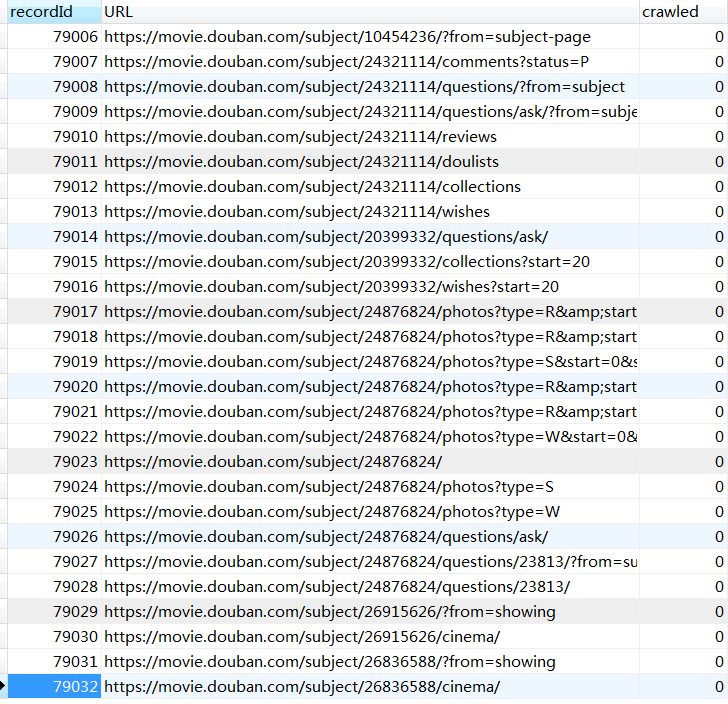
其中存储的是79032条,爬取过的网页有48471条 。
movie表 。
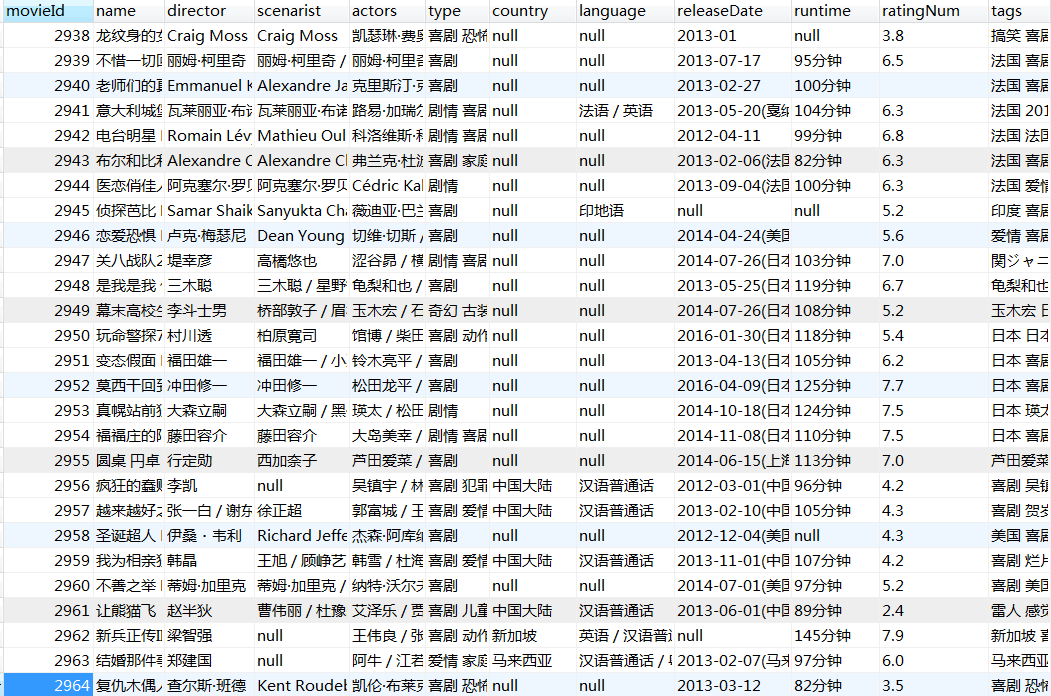
目前爬取了2964部影视作品 。
comments表 。
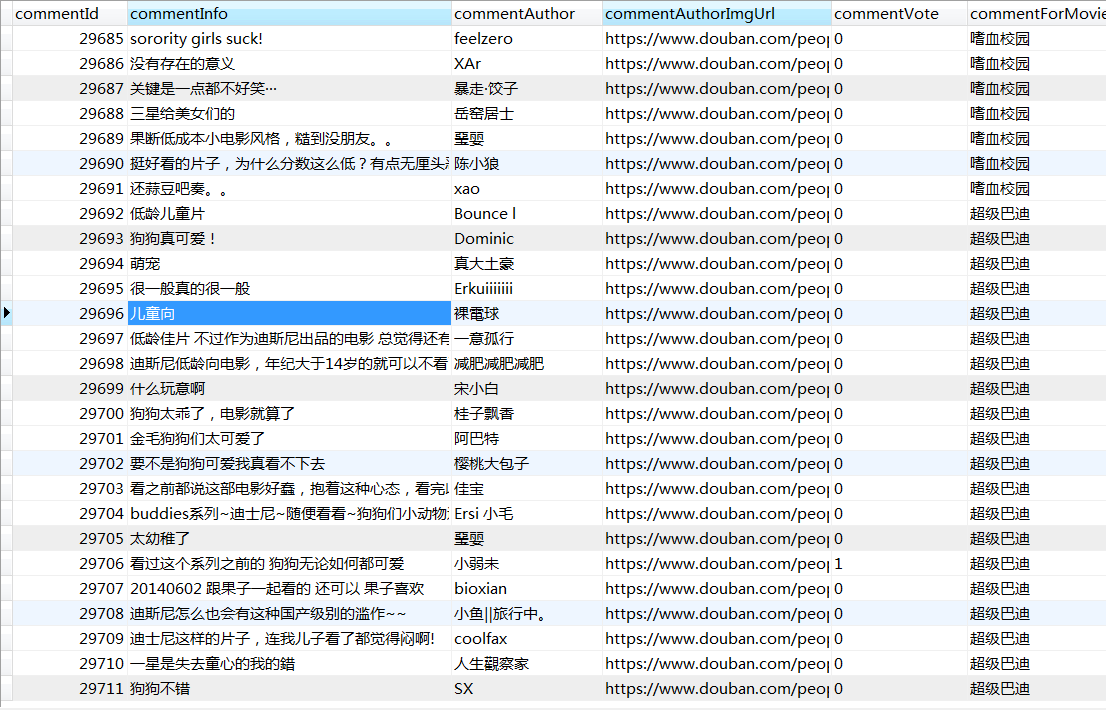
爬取了29711条记录 。
以上就是本文的全部内容,希望对大家的学习有所帮助,也希望大家多多支持我.
原文链接:http://www.cnblogs.com/bigdataZJ/p/doubanmovie3.html 。
最后此篇关于详解Java豆瓣电影爬虫——小爬虫成长记(附源码)的文章就讲到这里了,如果你想了解更多关于详解Java豆瓣电影爬虫——小爬虫成长记(附源码)的内容请搜索CFSDN的文章或继续浏览相关文章,希望大家以后支持我的博客! 。
我正在编写一个具有以下签名的 Java 方法。 void Logger(Method method, Object[] args); 如果一个方法(例如 ABC() )调用此方法 Logger,它应该
我是 Java 新手。 我的问题是我的 Java 程序找不到我试图用作的图像文件一个 JButton。 (目前这段代码什么也没做,因为我只是得到了想要的外观第一的)。这是我的主课 代码: packag
好的,今天我在接受采访,我已经编写 Java 代码多年了。采访中说“Java 垃圾收集是一个棘手的问题,我有几个 friend 一直在努力弄清楚。你在这方面做得怎么样?”。她是想骗我吗?还是我的一生都
我的 friend 给了我一个谜语让我解开。它是这样的: There are 100 people. Each one of them, in his turn, does the following
如果我将使用 Java 5 代码的应用程序编译成字节码,生成的 .class 文件是否能够在 Java 1.4 下运行? 如果后者可以工作并且我正在尝试在我的 Java 1.4 应用程序中使用 Jav
有关于why Java doesn't support unsigned types的问题以及一些关于处理无符号类型的问题。我做了一些搜索,似乎 Scala 也不支持无符号数据类型。限制是Java和S
我只是想知道在一个 java 版本中生成的字节码是否可以在其他 java 版本上运行 最佳答案 通常,字节码无需修改即可在 较新 版本的 Java 上运行。它不会在旧版本上运行,除非您使用特殊参数 (
我有一个关于在命令提示符下执行 java 程序的基本问题。 在某些机器上我们需要指定 -cp 。 (类路径)同时执行java程序 (test为java文件名与.class文件存在于同一目录下) jav
我已经阅读 StackOverflow 有一段时间了,现在我才鼓起勇气提出问题。我今年 20 岁,目前在我的家乡(罗马尼亚克卢日-纳波卡)就读 IT 大学。足以介绍:D。 基本上,我有一家提供簿记应用
我有 public JSONObject parseXML(String xml) { JSONObject jsonObject = XML.toJSONObject(xml); r
我已经在 Java 中实现了带有动态类型的简单解释语言。不幸的是我遇到了以下问题。测试时如下代码: def main() { def ks = Map[[1, 2]].keySet()
一直提示输入 1 到 10 的数字 - 结果应将 st、rd、th 和 nd 添加到数字中。编写一个程序,提示用户输入 1 到 10 之间的任意整数,然后以序数形式显示该整数并附加后缀。 public
我有这个 DownloadFile.java 并按预期下载该文件: import java.io.*; import java.net.URL; public class DownloadFile {
我想在 GUI 上添加延迟。我放置了 2 个 for 循环,然后重新绘制了一个标签,但这 2 个 for 循环一个接一个地执行,并且标签被重新绘制到最后一个。 我能做什么? for(int i=0;
我正在对对象 Student 的列表项进行一些测试,但是我更喜欢在 java 类对象中创建硬编码列表,然后从那里提取数据,而不是连接到数据库并在结果集中选择记录。然而,自从我这样做以来已经很长时间了,
我知道对象创建分为三个部分: 声明 实例化 初始化 classA{} classB extends classA{} classA obj = new classB(1,1); 实例化 它必须使用
我有兴趣使用 GPRS 构建车辆跟踪系统。但是,我有一些问题要问以前做过此操作的人: GPRS 是最好的技术吗?人们意识到任何问题吗? 我计划使用 Java/Java EE - 有更好的技术吗? 如果
我可以通过递归方法反转数组,例如:数组={1,2,3,4,5} 数组结果={5,4,3,2,1}但我的结果是相同的数组,我不知道为什么,请帮助我。 public class Recursion { p
有这样的标准方式吗? 包括 Java源代码-测试代码- Ant 或 Maven联合单元持续集成(可能是巡航控制)ClearCase 版本控制工具部署到应用服务器 最后我希望有一个自动构建和集成环境。
我什至不知道这是否可能,我非常怀疑它是否可能,但如果可以,您能告诉我怎么做吗?我只是想知道如何从打印机打印一些文本。 有什么想法吗? 最佳答案 这里有更简单的事情。 import javax.swin

我是一名优秀的程序员,十分优秀!